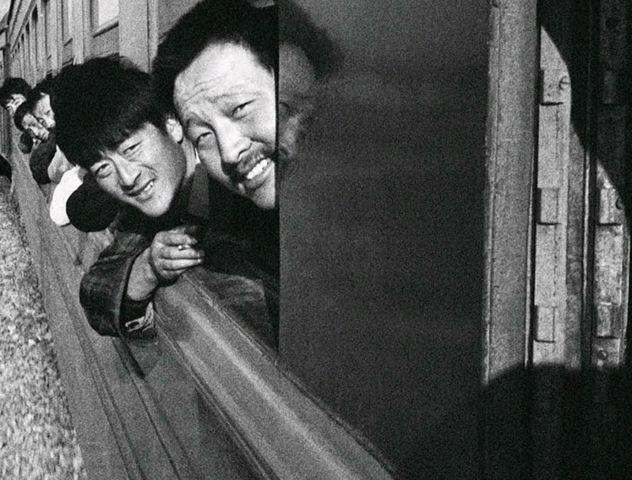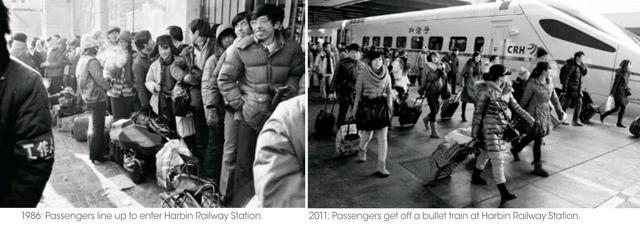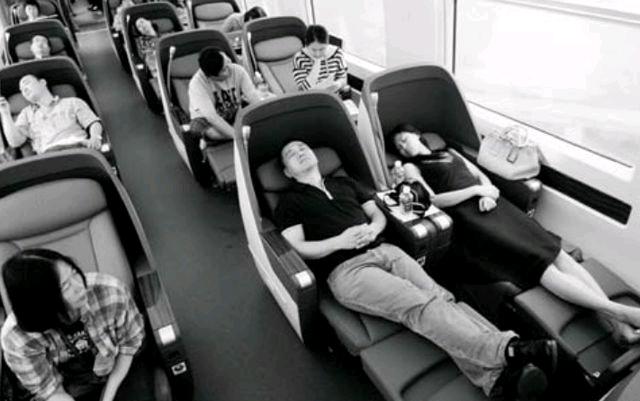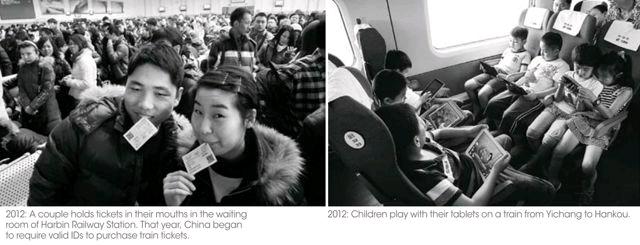Wang Fuchun:Lifelong Dedication
by+Zhu+Yinan
Along with the economic and social development of China, increasing numbers of Chinese people shuttle between
their hometowns and other places in the country for work,
study, travel and other reasons. People even coined the
term chunyun (“Spring Festival Travel Rush”) to refer to the
tremendous population migration during the Spring Festival holiday, the most important traditional Chinese festival. The primary means of transportation most ordinary Chinese people can afford, the railway has witnessed massive migrations for generations. Over the past four decades, Wang Fuchun, a renowned freelance photographer, has
remained dedicated to photographing one particular subject: People on trains. By doing this, he recorded the transformation of Chinese society with his lens.
Wang Fuchun, a native of Harbin, Heilongjiang Province, didnt realize that shooting people on trains would become his lifes work when he snapped his first photo of passengers more than 40 years ago. His name and career have since been linked to the rails.
“My Most Favorite Job”
Early in the 1990s, the widely acclaimed photography publication Black Lens printed several of Wangs photos de- picting people on trains: Passengers killing time by playing mahjong, a young couple gazing each other with tenderness despite being crammed on a seat… Impressed by his photography, fans remembered Wangs name. At the time, Wang worked for the railway and hadnt intentionally chosen to photograph people on trains.
In 1977, due to his talent of drawing comics, Wang was hired by the publicity department of the trade union of Sankeshu Deport under Harbin Railway Bureau. He had never before operated a camera when he was commissioned to take photos of an exemplary employee. Wang remembers it was an outdated Seagull.
He has hardly been able to put down cameras since. “I began to take pictures on trains in 1978 when China had just implemented its reform and opening-up policy,”Wang recalls. “As a railway employee, I could ride trains for free and often traveled by rail. In the beginning, I just aimlessly recorded things I saw on trains with my camera.”
During the 1980s and 90s, Chinas railway sector underwent enormous changes, as did Chinese society. The visible changes on trains reflected the changes of all of Chinese society. As an amateur photographer working for the railway, Wang was afforded many opportunities to take precious historic photos of train passengers.
During his employment, Wang was offered a promotion, but would have had to give up photography. He refused twice. In 1984, he became a professional photographer for an institute under Harbin Railway Bureau. The post secured Wang greater resources such as film and equipment, and he could devote more energy to photographing life on trains.
Wang spent so much time on trains that he couldnt sleep without hearing the clanking of the tracks. When traveling, he always hung a camera around his neck so that he could snap anytime. He still regrets missing some scenes. “Its hard to achieve perfection,” he sighs. “Perhaps this is also a philosophy.”
In 1998, Wang took early retirement from Harbin Railway Bureau so he could spend even more time on photography. Over the following years, several Beijing media organizations tried to recruit him as a photojournalist, but Wang refused in favor of freelancing.
“For decades, my life has been intertwined with rails and photography,” he grins. “At forks in the road, I stuck to photography because its my favorite job and Im happy to make it my lifelong career.”
“Study of Humans”
Before he eventually decided to solely embrace people on trains, Wang attempted to explore some other photographic projects, including “Steam Locomotives in China,” “Black Earth,” “Households in Northeastern China” and “Siberian Tigers”series. “Just like digging wells, a photographer has no idea which projects will become successful in the beginning. You might find water after a single shovelful. But most times, photographers dont have the patience to dig deep enough into their projects and just walk away after a feeble attempt. If I have confidence in a project, I just keep digging until I find water.”
After taking some 10,000 photos of people on trains, Wang finally realized the subject was his destiny. “These historic photos didnt seem like anything special at the time they were taken, but theyre profound after so many years,” he explains.“I spent 20 years photographing Siberian tigers, but the animal looks the same with the passage of time. However, peoples lives saw tremendous shifts over past decades. In the photos I took in the 1970s and 80s, most people wore similar monochromatic clothes. In the late 1980s, women began to grow longer hair and bell-bottoms became popular with youngsters. Clothes have become increasingly variable since the 1990s, and now people hate to wear the same as others.” Gradually, Wang gave up his other photography projects and stuck to people on trains.
In 2001, Wang published the album Chinese People on Trains, which captures the changes of Chinese society over decades. In 2006, Chinas railway sector witnessed a major upgrade with the introduction of high-speed trains. Wang embarked on another journey with people on trains.
Changes in everyday life are so fast and numerous that Wang can hardly find time to capture it all anymore. “Take cell phones as an example,” says Wang as he displays some of his photos depicting passengers using their phones. “The early handsets were cumbersome, and theyve become increasingly smaller and thinner. But in recent years, smartphones with bigger screens have become popular.”
“When television sets first arrived on trains, everyone was glued to them,”he adds. “But now, few raise their heads to watch television sets on carriage ceilings and instead bury their noses in laptops, iPads or smartphones. What a big change!”
Wang pays great attention to details. In his eyes, documentary photography is a piece of the study of humans. Scenes Wang photographed were everyday life – familiar but ignored. Through decades of practice, he developed an acute sense to pinpoint emotional and interesting scenes of everyday life. “Whether a photo is beautiful doesnt matter,” he opines. “The important thing is that it can record history.”
“In 2016, the country will see its 38th year of reform and opening-up, and Im going to reopen the project to photograph people on trains,” asserts Wang. “Time flies. Ill use my photos to record the course of Chinas railway development over four decades.”
China Pictorial2015年2期
